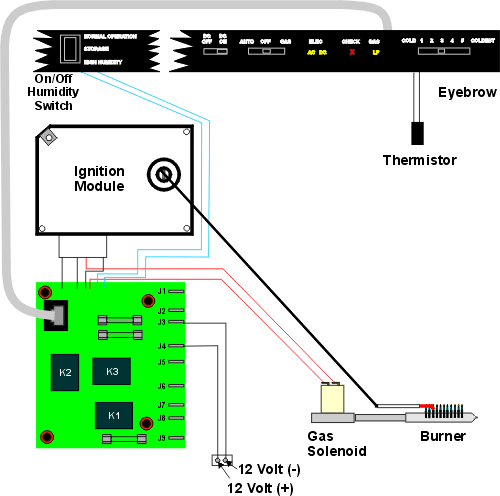Dave's Place
Norcold Second Generation Gas Operation
Before attempting any repairs or testing, check out the gas safety and electrical safety pages.

This graphic is a simplified view of the necessary components of the gas system.
When Gas is selected, either automatically or manually, the Power Supply Board sends 12 volt to the Ignition Control Module which then opens the gas solenoid valve (letting gas through to the burner) and also sends a spark to the burner electrode which then lights the gas flame. Older versions of these refrigerators had two electrodes, which can best be explained at the Ignition Control Module page. When the set temperature inside the refrigerator is reached, the thermistor "tells" the refrigerator and 12 volt is taken away from the Ignition Control Module, which causes the gas solenoid to close and the gas flame to go out. Also, the spark voltage for the electrode is disengaged. When the voltage is present (during normal operation), the electrode would immediately start sparking if the flame were to go out. Unlike manual refrigerators which have a high and low gas flame, the burner on these models is shut down and relit as necessary.
Although the connection to the Ignition Control Module is the same, please note that the 8600 and 8700 series models use different terminals eleswhere.
Troubleshooting
If you have a problem with the gas operation, it's often a good idea to test the refrigerator on AC
before going any farther. This lets you know that a few common components are working. The heart of
the gas system is the Ignition Control Module. Once you have established that you have 12 volt to
the module and the gas flame still doesn't light, you should go to the
Ignition Control Module page for the rest of the testing.
If you don't have power to the Ignition Control Module, the most likely problem is the Power Supply Board, assuming fuses and input voltage have been tested. However, the eyebrow board (where appropriate) shouldn't be overlooked. Go to the Eyebrow page for testing it.
If your burner lights and the refrigerator doesn't cool well on propane (but does on AC), you need to go back to the basics of gas heat. See the burner and orifice page for help.Norcold Electronic System (second generation) Home
RV Refrigerator Home
This RV refridgerator information was originally located on rvmobile.comRV Mobile Inc. 11715 HWY 99, Everett, WA 98204
The owner of RV Mobile Inc. apparently suffered a heart attack and the original website was shut down.
It has been reposted here to preserve this wealth of information RV refridgerator information.